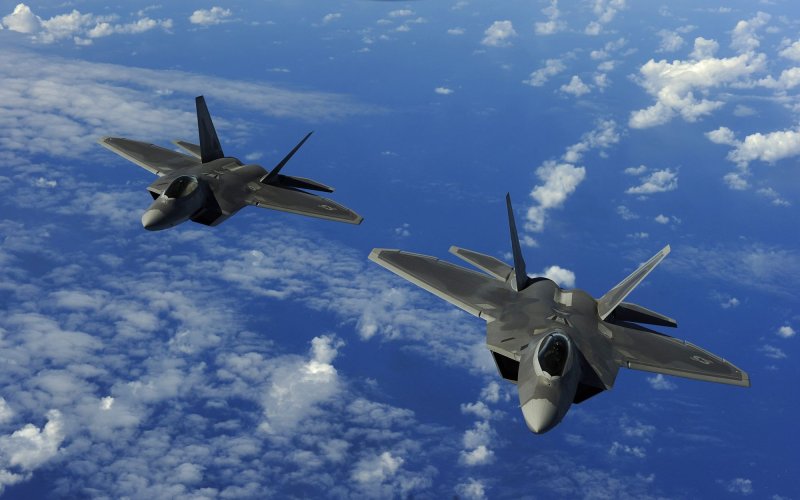1 of 2 | U.S. Air Force F-22 Raptor aircraft assigned to the 90th Fighter Squadron out of Elmendorf Air Force Base, Alaska, fly near Guam, Feb. 16, 2010. UPI/Jacob N. Bailey/U.S. Air Force |
License Photo
WASHINGTON, Aug. 1 (UPI) -- Multiple factors contributed to oxygen problems experienced by pilots of the F-22 Raptor, a top Air Force officer said Wednesday in Washington.
Maj. Gen. Charles Lyon told reporters that while "in the end, there is no smoking gun," he has "high confidence that we have eliminated the major contributors to this problem."
Among the contributing issues, Lyon said, were a malfunctioning valve on the pilot's upper pressure garment, the hoses and connectors in the pilot's gear and a charcoal filter installed after the breathing problems were firsts reported.
The F-22 fleet had been grounded last year as the Air Force was unable to figure out why pilots were experiencing "hypoxia-like symptoms" -- including dizziness, lightheadedness and judgment impairment.
The single-pilot, twin-engine fighter jets, produced by Lockheed Martin, cost about $420 million apiece. The U.S. government bought 185 of them.
Lyon said the flaws in the oxygen system were unrelated to a 2010 F-22 crash that claimed the life of the pilot, whose oxygen system shut down entirely.
Some instances in which ground crews said they experienced symptoms while working on the aircraft may have been due to other factors, such as breathing jet exhaust, dehydration or dietary issues, he said.
F-22 pilots are no longer wearing the pressure vests, which are being redesigned with a new valve. The planes will be provided with an automatic emergency back-up oxygen system.
The general said since the last "unexplained incident" occurred March 8, Air Force pilots have flown nearly 8,000 sorties totaling more than 10,000 flight hours. While local flights were mostly limited to 30 minutes, longer flights are now being permitted, Lyon said.
"In the end, there is no smoking gun," he said. "We have assembled the pieces of the mosaic. They reside in the cockpit. Some of them are here before you today, in the upper pressure garment, in the oxygen delivery hoses, in the quick connection points and for a short time, in the air filter canister.
"As we completed end-to-end testing in the life support systems components, we were able to piece together the contributing factors for our previously unexplained incidents.
"And I must add that it was only through an integrated, collaborative approach by government and industry that we got to where we are today.
"So how did we eliminate contamination as the root cause? We did this through months of exhaustive testing and flight testing line operational aircraft. We pored over aircraft involved in incidents. We analyzed thousands of samples of gasses, volatile and semi-volatile compounds, solids, liquids, and particulate matter.
"We compared these samples to occupational hazard standards. And we checked the levels in incident aircraft and pilots against non-incident aircraft and pilots. We found nothing remarkable."
Lyon said before F-22 flight operations return to normal an independent oxygen sensor will be installed in the cockpits and a finger-mounted pulse oximeter will be provided. The new pressure vest valve must be tested and installed, and NASA must complete its independent analysis of the oxygen problem. That report is expected in September, Lyon said.















